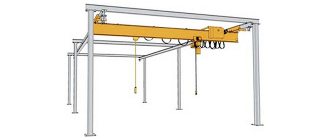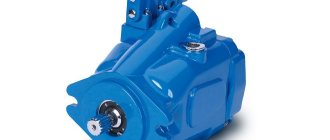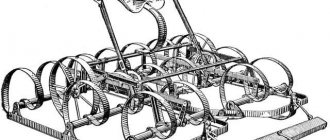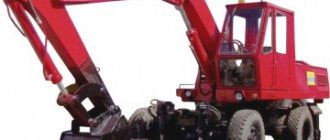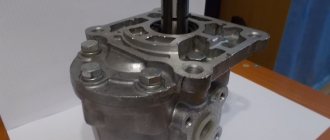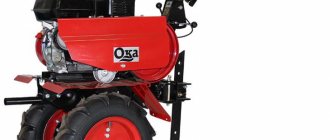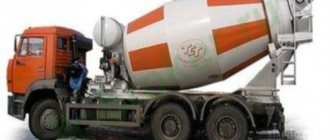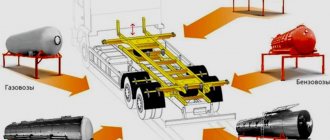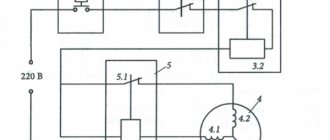Drainage pumps are indispensable assistants in solving many problems related to water transportation. Thanks to their compact dimensions and ease of installation, these “universal soldiers” will help you quickly cope with any problem - from pumping unclean water from a well to draining an area.
In order for the unit to cope with the tasks assigned to it, and for the purchase to justify itself with uninterrupted operation, it is necessary to carefully approach the issue of choosing a device.
We will tell you how water drainage pumps work and which models are appropriate to use in a given situation. In addition, we will identify reliable equipment manufacturers and list the main criteria for choosing drainage pumps.
Operating principle of the unit
By pumping out water, a sump pump removes it from a filled tank or flooded room to a nearby structure. In this case, the processed liquid first enters the working chamber, and then, thanks to the created pressure under the action of the pump wheel, it moves towards the outlet pipe.
Thanks to the design of most drainage pumps, in which the impeller has a semi-open design, the units are able to pump large portions of liquid in the shortest possible time.
Due to the fact that devices of this type are not capable of creating high pressure, they cannot lift and pump water over long distances
The pumped liquid simultaneously performs the function of cooling the engine. Thanks to this, the likelihood of the pump overheating during prolonged operation is reduced to zero. But for the same reason, drainage pump manufacturers impose restrictions on the maximum temperature of pumped water. For most models it should not exceed 50°C.
There is also equipment on sale that is capable of operating in non-standard conditions and hot environments. But such equipment costs an order of magnitude more.
Drainage pumps are able to operate effectively in environments with varying degrees of contamination.
The units offered for sale are divided into three categories:
- For clean and slightly polluted water. Pump water containing particles with a maximum size of 5 mm. They are used for water intake from water-reducing wells, emptying swimming pools and pumping water from rainwater tanks.
- For moderately polluted waters. The size of solid particles transported with water does not exceed 25 mm. They are used to empty storm drains and drainage wells.
- For dirty liquid with inclusions 38 mm. They are used to empty storage tanks and pump out dirty water during floods.
The performance of devices designed for clean and slightly contaminated water ranges from 83 to 230 l/min. And the supply of pumped out liquid can reach from 5 to 12 m.
These parameters are quite sufficient to ensure the operation of fountains, water supply and drainage systems, as well as the operation of irrigation installations
To pump dirty water, including gravel and similar particles with a diameter of 10 to 15 mm, units with a capacity of 37 to 450 l/min are used. They are capable of supplying water to a height of 5 to 22 meters.
Industrial drainage models designed to work with sewer systems can “digest” particles up to 120 mm in size.
The main difference between drainage installations and well pumps is the ability to pump out water that contains various types of impurities
Drainage installations are able to work most efficiently only with liquids that have a minimum content of solid elements.
Fecal pumps with a grinder can handle contaminated water saturated with solid waste.
Image gallery
Photo from
Drainage pump for dirty water
Differences in drain characteristics
Built-in safety devices
Drainage equipment housing
In what cases is it used?
The scope of application of the pump can be divided into several well-known areas, such as:
- pumping water from wells during cleaning and repair work;
- drainage of wells during their restoration;
- elimination of flooding in the event of a sewerage break;
- maintaining dry floors in the cellars (an automatic control unit is mounted on the device, which is responsible for the timely switching on and off of the unit);
- watering beds and gardens from special tanks;
- sewage treatment;
- maintenance of swimming pools and home decorative ponds;
- pumping out rainwater.
Each of the listed tasks requires the selection of the appropriate pump model.
Classification of pumps by type of design
The variety of pumping equipment is divided into two categories: surface and submersible units.
Surface models
Surface units are designed to be installed above a tank. The housing of devices of this type is placed on a flat surface in a dry place. Water is pumped out through a sleeve lowered into the tank: a PVC pipe or rubber hose.
Surface pumps are mobile and easy to operate: they are convenient to transport around the site, installing them in the right place temporarily or permanently
Any surface model has two pipes:
- inlet – ensures the flow of wastewater from a filled container;
- exit - drains wastewater outside the emptied structure.
Such devices can operate automatically. To implement automatic operation, a float mechanism is attached to the switch on, which responds to the level of liquid in the tank.
It is immersed in the pumped-out liquid along with the hose. When the water rises above a certain mark, the float sensors are triggered, causing the pump to start.
The main advantages of submersible units are:
- ease of installation and dismantling;
- Maintenance of the device comes down to timely cleaning and lubrication of parts.
But such units are not suitable for deep sources. They are designed to operate at a suction height of 8-12 m.
It should also be taken into account that when connecting such a pump to the sewer system, you need to know exactly the cross-section of the pipeline, since the unit is connected to it using pipes.
Image gallery
Photo from
Drains for accident elimination
Pump float switch
Durable fiberglass body
Connecting the water supply pipe
Submersible drainage devices
Submersible devices operate in almost the same way as surface drainage pumps. But they are more designed for pumping water from deep trenches or cleaning wells.
Pumping of wastewater is carried out by the pump itself without the use of hoses and pipes. A mesh filter located at the bottom of the pump protects the unit elements from hard soil, sand and insoluble particles.
The maximum immersion depth of pumps for different models usually does not exceed 50 m. But they cannot be used when emptying small tanks and reservoirs, the depth of which does not reach 20 m. To be able to operate submersible devices in shallow trenches, it is necessary to use additional cooling of the engine with water.
Submersible units are installed at the bottom of the tank, and water is sucked in directly through a grate located at the bottom of the housing
The installation depth of the unit depends on the type of tank. But there is a simple rule: the lower the submersible pump is located, the easier it will be to work with.
Among the main advantages of submersible devices it is worth highlighting:
- high power and performance compared to surface units;
- the ability to drain deep tanks of several tens of meters;
- Quiet operation - units immersed in a container produce virtually no noise during operation.
A special feature of this type of installation is that it operates automatically. Equipping the device with a float mechanism or a plastic bubble ensures uninterrupted operation of the pump in automatic mode. It turns off the pump motor when the preset water level is reached.
The presence of a float switch is especially important when it is necessary to pump out liquid from slowly filling tanks
Constant operation of the device under water requires reliable insulation of the automation and sealing of the electric motors of the device. Therefore, in the manufacture of submersible units, only corrosion-resistant materials that can withstand mechanical damage are used.
Depending on the purpose and perceived loads, the manufacturing materials for key parts can be:
- polymers and engineering plastics;
- electrical, alloy and carbon alloys and steels.
In expensive models, seals made of ceramic cuffs or with an oil lock are used to seal the electric motor of the device.
The only drawback of submersible devices is that in order to service and repair the drainage pump, it must be removed from the tank to the surface. And due to the tightness of the housing, they are quite problematic to maintain and repair.
Price issue and quality
The cost of pumps directly depends on the manufacturer and the main technical characteristics - power and performance. European pumps are high-quality and expensive units designed for a long service life.
Domestic brands are sold at budget prices. However, this does not mean that the pumps are much inferior in quality and reliability to their famous competitors. Often they are even better adapted to our operating conditions. For example, they are not afraid of voltage surges in the electrical network.
Types of pumps by purpose
Depending on the power of the devices and their area of application, drainage pumps are conventionally divided into two types: household and industrial.
Household units
Drainage pumps designed for domestic needs have a wide range of applications.
They are used:
- for pumping water out of flooded cellars and basements;
- emptying technical wells;
- pumping water from swimming pools;
- watering the garden from a pond or barrel.
Single-phase low-power pumps have an average capacity of 800 l/minute and are capable of moving water extracted from a tank, pond, or well to a height of up to 25 m.
Drainage installations are often used in irrigation and watering systems, as well as to ensure rapid water supply for the functioning of a fountain.
For domestic needs, drainers are most often purchased, the body of which is made of stainless steel or reinforced polymer. They are capable of pumping water containing solid impurities up to 10 mm in size, the ratio of which is 10% of the total volume.
Pumps for industrial purposes
Industrial drainage pumps have higher power and performance. Motor pumps and diesel pump units are widely used by utilities, construction companies and the Ministry of Emergency Situations.
With their help they produce:
- pumping out sewer tanks and clogged pipelines;
- elimination of emergency flooding;
- drainage of industrial waste;
- drainage of collector pits and other objects.
On an industrial scale, drainage pumps are most often used with electric motors placed in cast iron housings. The powerful radiator of such devices ensures effective heat removal, and the cast-iron body protects against deformation during significant heat generation.
They are capable of pumping wastewater and dirty water, including particles up to 20 mm in size, the ratio of which is 25% of the total volume
Industrial three-phase pumps are characterized by suction speeds of up to 1500 l/min. They are capable of lifting processed water to a height of about 150 m.
Such models have a more complex design. To carry out maintenance, they require the involvement of a specialist.
Device
The product has a durable steel body (less often made of durable plastic or cast iron), inside of which there is a motor compartment and a pump chamber with an impeller. When the shaft and impeller rotate, the liquid is constantly thrown towards the walls of the pump chamber, creating a vacuum zone in the area of the intake hole. Centrifugal force provokes powerful suction of liquid.
The inlet pipe is equipped with a mesh filter, the mesh sizes of which have a strictly specified size. Fecal models have larger cells, while drainage models have smaller cells. The impeller (usually one wheel with blades) is designed in such a way that dirty water flows through the housing without causing silting of the rotating units.
In a simplified form, the design of the device includes:
- Electric motor.
- Shaft with impeller . It can be located on the engine itself or separately, but the essence does not change - this element ensures the movement of water inside the device. Made from stainless steel.
- Pump unit with intake pipe . Through the holes in it, water enters the pump. The diameter of the holes determines the size of solid particles that are allowed to pass through.
- Frame . For household products, it is made of plastic or steel. This ensures their mobility and ease of use. At the same time, plastic is more sensitive to working with solid particles, so devices in a plastic case fail faster.
- Float switch . Prevents flooding and dry running of the product by automatically turning it on or off depending on the water level.
Leading manufacturers of drainage pumps
The pumping equipment market today offers a wide selection of drainage units from various manufacturers, both domestic and foreign.
Among buyers, the models produced under the following brands are in greatest demand:
- Grundfos is a Danish company specializing in the production of pumping equipment, including electric motors and components for them. The wide range of models includes both external and submersible devices designed for pumping clean and dirty water of various temperatures. Units produced under this brand belong to the high-price segment, since prices for models are one and a half times higher than the average.
- Perdollo , an Italian company, guided by the principle of helping humanity solve the problems of water supply, produces a new generation of pumps. The manufacturer's catalog contains hundreds of models, differing in purpose, design and performance characteristics. The wear-resistant and reliable devices they produce, despite their rather high cost, have a lot of positive customer reviews from different parts of the world.
- Wilo is a German brand that appeared on the domestic market more than two decades ago and is famous for the introduction of the latest technologies and modern design. The company produces high-quality equipment for water supply and sewerage systems, as well as ventilation and air conditioning.
The enterprises of each of the listed companies have multi-stage quality control. Their products comply with international quality and safety standards.
How to choose the right submersible device for dirty water
Of course, the choice is based on the concentration of dirt in the pumped water. It is by this criterion that pumping equipment of this type is most often selected. If you make a mistake, the chamber where the impeller is located will become clogged with dirt, and in the best case, the pump will turn off, and in the worst, its electric motor will burn out. Therefore, you must first determine the same concentration, and only then buy the unit itself.
There are other technical characteristics that must be taken into account as criteria for choosing a submersible pump.
- The volume of dirty water pumped over a certain period of time. That is, this is the performance of the device. And the larger it is, the more expensive the pump itself is.
Attention! If it comes to pumping dirty water in a suburban area, then it may not be worth looking at this characteristic. After all, sometimes the deadline for completing the work does not matter. You can pump out the required volume of liquid in 2 hours, or in 4. So the second unit will cost less.
After the flood - Pressure is an important selection criterion. After all, there are situations when you need to pump out dirty water from a fairly large depth. And the more pressure the pump has, the deeper it can be lowered. By the way, drainage pumps for pumping water from a well are most often chosen precisely for this indicator. Especially if you need to pump water over a long distance horizontally.
- And one more criterion is the temperature threshold, meaning its maximum value. As mentioned above, the pump motor is cooled by the pumped liquid, so the maximum temperature value is +50C.
A few words about submersible drainage pumps with a built-in float, the latter serves as a switch. Purely structurally, the float is a sealed block in which a contact and a metal ball are located. The internal space of the float is filled with air, so it floats freely on the surface of the water. As soon as the water level drops to a critical level, the float lowers and the ball rolls in it, disconnecting the contacts of the electric motor. That is, the pump turns off.
Float with metal ball
This is a very important point because the submersible pump is located in the water. And if it runs out, then the device itself begins to idle. Water does not pass through it, and therefore does not cool the electric motor. Consequences - the engine overheats and burns out. And these are big problems associated either with pump repair or with the purchase of a new unit.
The same thing, only in reverse, happens with the pumping unit when dirty water begins to accumulate in the tank. As soon as it reaches a certain level, the float floats up, the ball rolls into place and closes the contacts through which electricity is supplied to the pump motor.
Float pump unit
Recommendations for choosing equipment
The first thing you should focus on when choosing a unit is the conditions of its use and the degree of water contamination.
The nominal diameter of the pump will correspond to the maximum size of solids that it is capable of pumping
When choosing drainage equipment for water, you should focus on the technical characteristics of the product:
- Performance. It is determined based on the amount of work that the unit must perform. That is, how much liquid it should pump out over a specified time period. The emphasis should be on the most complex process.
- Pressure To determine this parameter, you should know the approximate height and distance over which you plan to transport water. This indicator is calculated as the difference between the mark of the water outlet from the pipe and the immersion depth of the unit.
- Pumped out medium. The maximum permissible size of solid inclusions to be pumped with water is specified in the device specification. In models designed to work with contaminated water, the dimensions of the working chamber must be such as to ensure the unhindered passage of fractions.
- Maximum temperature threshold. When choosing a submersible model, focus on the maximum temperature threshold of the pumped liquid, since the engine of such a unit is cooled by transferring thermal energy into the transported liquid. In most cases, the maximum water temperature threshold is 50°C.
The maximum productivity of household units is 180 l/min. This is quite enough to drain the tank or remove water from the cellar. To be able to pump water from the bottom of a tank or well in optimal mode, choose models whose suction holes are located at the bottom.
When calculating the required power, you should take as a basis the parameter that one meter of vertical water intake will correspond to ten meters horizontally.
The pressure and performance of the drainage pump are interrelated: the greater the immersion depth of the device, the less pressure created (+)
When choosing a model, also take into account the condition of the surface where the equipment will be placed. It is better to place a surface drainage pump in a pit measuring 40x60 cm. This will prevent water from spreading over a flat surface.
If you use automation, which assumes a vertical position of the float, then the surface will remain completely dry. After all, when configured correctly, the float mechanisms work properly and reliably.
Regardless of the type of model designed for pumping clean liquid, it should be taken into account that it should not be used near the silty or sandy bottom of a reservoir. Particles entering the device will clog it, which can negatively affect the service life of the unit.
Additional information on the design features of drainage pumps and tips on choosing equipment are provided in this article.
Exploitation
Choosing the right drainage pump is only half the battle. How successfully and long it will be used depends on compliance with the operating rules:
- the unit cannot be used in water with solid impurities the size of which it is not designed for;
- It is prohibited to pump explosive and flammable liquids (for example, gasoline);
- It is not recommended to move the equipment during operation;
- The technical data of the pump must correspond to the scope of its application (performance, depth, degree of contamination of the liquid are taken into account).
Cleaning a heavily silted well
It is difficult to clean such wells with a household drainage pump: it quickly becomes clogged with sand and cannot cope with the job. Professional equipment would have been more useful here, but the craftsmen found a way out.
First, preliminary work is carried out. Need to find:
- barrel with a volume of 200-300 l;
- surface pump or budget vibration pump;
- sand filter.
The container is installed near the well.
First, clean water is pumped out so that as little of it as possible remains, about 1 m. It is sent through a hose beyond the boundaries of the site or found another use. Now you can start cleaning the source from sludge.
The technology is as follows:
- A drainage pump pumps muddy water into a barrel.
- From there it is fed under pressure back into the well. But it is already clean - the filter does not allow sand to pass through.
- The sand is washed away by a strong jet, the drainage pump captures the muddy liquid and delivers it upward.
The process goes on almost continuously. They stop only to lift the device and rinse with clean water any deposits in the water channel, which can lead to equipment failure.
